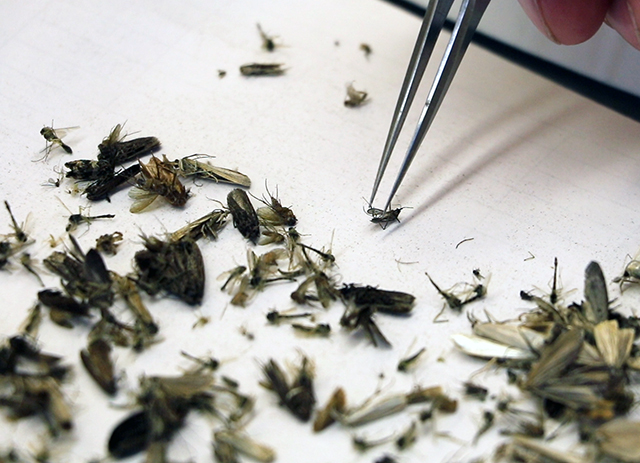Keeping track of how many tiny mosquitoes there are in Winnipeg may seem like a challenge, but with the help of a little bit of light, the City’s Insect Control Branch can monitor the pesky insect.
“We use a network of more than 35 New Jersey Light Traps in and around the city,” said David Wade, Surveillance Program Coordinator.
The traps are located in the same spots every year and run 24 hours a day from the beginning of May to the end of September. The contents of the collection jars are then brought inside to be counted at least three times a week.
In addition to attracting mosquitoes, other insects including moths can also be caught in the traps. Employees carefully sort through all the insects focusing on isolating mosquitoes.
“The numbers of male and female mosquitoes are recorded and the female mosquitoes are then identified to species,” said Wade.
The most common type of mosquito, aedes vexans, makes up 95 per cent of the adult mosquitoes collected in the traps. Wade said the eggs of this species hatch after a summer rain. Other species found include the cattail mosquito, culex tarsalis, and culex restuans.
“Data from these traps are used to evaluate the success of the mosquito larviciding program and the effectiveness of a fogging program,” said Wade.
Trap counts are then posted on the City’s Insect Control website.

“The adult nuisance mosquito count is one of the components of the City’s Adulticiding Factor Analysis (AFA),” said Wade. “Other components of the AFA include rainfall, temperature, and soil moisture.”
The AFA is used to determine when mosquito control, or fogging, is required. As outlined in the Adult Mosquito Control Policy, fogging is considered when the AFA is high.
During a fogging program, the Insect Management Areas scheduled for fogging are announced at least 8 hours in advance. Fogging will then occur daily from 9:30 p.m. to 6:30 a.m. weather permitting until the program concludes. The City controls adult mosquitoes along streets and lanes, City parks, golf courses, cemeteries, and rights-of-way within the City boundaries using DeltaGard for ultralow volume applications.
Residents can register online to receive mosquito control program notifications.
